|
|
Sir Hercules

|
|
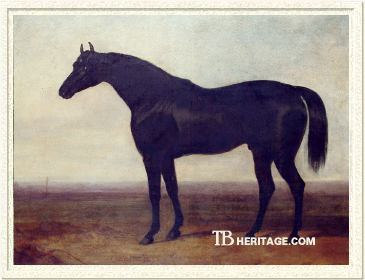 |
|
|
The Irish-bred Sir Hercules (out of English parents), was a good stayer with a nice burst of speed, who won in Ireland and England. The most influential son of Whalebone, he got some good sire sons, most notably Birdcatcher, through whom the sire line descended through The Baron, Stockwell, Doncaster, and many other notables up to the present. He also was influential in the pedigrees of jumpers, and some of his sons became noted steeplechase sires.
Sir Hercules was gotten by the long-running, hard-knocking Derby winner Whalebone, one of the most influential sires in the history of the thoroughbred, and, along with Whalebone's son, Camel, became one of his best sire sons. Whalebone stood at the Petworth stud of George O'Brien Wyndham, (3rd) Earl of Egremont, a man of enormous wealth and highly influential in the sporting world. His horses won the Derby five times, and his fillies won the Oaks five times as well. The Petworth stud produced a great many horses, with herds there numbering up to 300 or more.
Peri (1822) was a Petworth home-bred daughter of Egremont's Wanderer (by Gohanna), a horse that ran in top company, mostly at Newmarket, placing in the Port Stakes and other races, and running second to Cannon Ball in the Oatlands handicap. Her dam, Thalestris, was by Eclipse son Alexander, a good sire of many winners and dam sire of three influential sons, Castrel, Selim and Rubens. Thalestris ran in the north, and was taken out of training to produce a foal in 1913 for the Duke of Rutland, then resumed her career, running until the age of five, when she ran second in a 2 mile race at Chester. She was sold to Egremont and went to Petworth, where she produced thirteen foals; Peri, a bay, was her fifth. A sister to Peri, Mrs. Bang-up (1825) became the dam of a good runner, Morgan Rattler, who sired the 1859 Grand National winner Half-Caste.
Peri was bred to Whalebone at age three, so it seems unlikely she ever made it to the turf. She was purchased by a Mr. Lang and taken to Ulster, where she foaled out a colt, who, after losing his baby coat, was black with grey hairs in his tail, and some grey ticking on his flanks. He would pass the grey/white hairs in the tail, and often the grey/white ticking in his coat, on to many of his youngsters, regardless of their base coat. Named Sir Hercules, he was purchased by Hercules Langford Rowley, (2nd) Baron Langford, of Summerhill, County Meath, Ireland, who later also bought Peri. Sir Hercules, when full grown, was 15.2 hands tall, and many of his offspring were also close to this size. He was extremely compact, later measurements showing him to be of identical length "...From the center of the breast to the hind part of the shoulder, from hind part of shoulder to the hip, and from hip to whirlbone," with "no more than room for a saddle on his back." He inherited Gohanna's short stature, and broad forehead and small muzzle.
Sir Hercules on the Turf
Sir Hercules was undefeated in his limited juvenile season in Ireland. In England, running for Langford his entire career, he proved a modestly successful runner that could go a distance and beat some good winners.
At age two, in his first outing at the Curragh, running in a sweepstakes for juveniles, he won, beating four other youngsters. In the fall at the Curragh he beat Mount Eagle in a match for 100 sovereigns, and then was shipped over to England to race.
He started his three-year-old season at York Spring, where he won a two mile sweepstakes, beating the good colt Netherby and four other horses. He was taken to Doncaster that fall, and ran third in Rowton's St. Leger, with Voltaire second, with sixteen other horses in the race. At the same meeting he won a sweepstakes for three-year-olds, beating the good colt Fortitude (later winner of the Champion Stakes and Lincoln Gold Cup) and Richmond Stakes winner Zodiac.
The next season, 1830, he won the Claret Stakes at Newmarket Craven, beating three other horses in a canter. That appears to have been his only race that season. The following year, 1831, he ran unplaced in Liverpool's Stand Cup (won by Walton), which was his last appearance on the turf.
Sir Hercules in the Stud
In 1831 Sir Hercules went to stud at Summerhill at an initial fee of £10, and an advertisement stated a "proper person" would meet in-foal English mares arriving on the packet boats from Liverpool and Holyhead to assure their careful transition to Summerhill; there were few, if any, English takers, and any foals born in 1832 did not make much of a mark. In 1832, he was moved to the recently constructed Rossmore Lodge at the Curragh, which belonged to William Westerna (2nd Baron Rossmore).
He was shipped off to England in the fall of 1833, along with Langford's entire racing stud, for auction at Tattersall's Doncaster. He was sold to America for 750 guineas in the auction, but it was determined it was too late in the season to ship him overseas, and the horse was resold to H.O. Weatherby of East Acton, Middlesex, and stood, that first year at George Tattersall's stud farm at Dawley Wall Farm near Uxbridge (his dam, Peri, was sold to the King). In 1835 he was moved to East Acton, and in 1837 was leased to Mr. Stovin who had a fram at Small Heath, Birmingham. He was sent back to East Action in 1838, standing at a fee of £30 (with a rebate £10 of to owners whose mares came from the Continent, Ireland or Scotland).
Weatherby died soon after, and Sir Hercules was sold to Sydney Herbert (later Baron Herbert of Lea), conservative m.p. for Wilshire South, the eldest son of the (11th) Earl of Pembroke's second marriage. Herbert was later Secretary of War three times (under Robert Peel, the Earl of Aberdeen in the 1850s, directing the Crimean War, and again under Lord Palmerston). Herbert owned vast amounts of acreage in Ireland, including Mount Merrion, Stillorgan, Co. Dublin, in addition to Wilton House, west of Salisbury, in Wiltshire, and spent much of his time in both places. Sir Hercules was sent to join St. Leger winner Elis, which Sydney had purchased in 1837 at the close of his turf career, at stud in Wilton, and one year -- 1844 spent a season, with Elis, at Tattersall's Willesden Paddocks, where he was able to breed public mares, rather than be limited to Herbert's private broodmare band. Herbert broke up his stud, and Sir Hercules was purchased by Mr. Phillips of Bushbury Stud in Wolverhampton, where he lived out the rest of his years in "good quarters" with "...all that the most exquisite care and invigorating restoratives could promote." He rewarded this care with a number of foals gotten in his old age, including Gemma di Vergy, Lifeboat and (Young) Sir Hercules, before dying there at age thirty.
Sir Hercules' most influential offspring was Birdcatcher, grandsire, in tail-male, of Stockwell, "the Emperor of Stallions," in his 1833 crop born in Ireland. That crop also included two good fillies, Maria and Water Witch, both of whom won races in Ireland, and Arthur, a good steeplechaser who later became a sire of jumpers. His next Irish crop included the fillies Cruiskeen and Brunette, both long-running, hard-knocking winners of good races, Cruiskeen on the flat, and Brunette over fences. In England he sired three classic winners and some top stayers. Through his sons, he had an major influence on bloodlines in England, Ireland, France and America, and his daughters can be seen in the lines of stakes winners throughout the world. He also had an important influence on steeplechase breeding, siring a Grand National Steeplechase winner himself, and getting daughters and sons who bred many jumpers.
|
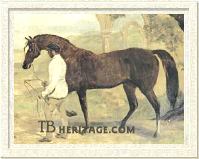
Birdcatcher
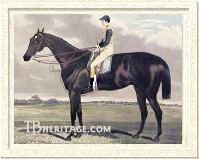
Faugh-A-Ballagh
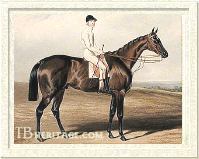
Coronation

Gemma di Vergy
| |
BIRDCATCHER (1833) was bred by George Knox at Brownstown Stud in Ireland, out of Martin Blake's small Bob Booty mare, Guiccioli, who was a good runner and winner of ten races. He was sold to William Disney of Lark Lodge at the Curragh, and despite being plagued by the lingering effects of an illness he contracted as a youngster, he won the Madrid Stakes, the Milltown Stakes, and the Peel Cup, among a total of seven wins in fifteen starts.
He retired to the Brownstown Stud at age five, and, after his first crops emerged as top races horses, including St. Leger winner The Baron, and Doncaster Cup winner Chanticleer, he was sent to stand at Barrow's Paddocks at Newmarket in England, also spending seasons at Easby Abbey near Richmond, Yorkshire. He was twice leading sire in Great Britain, siring five classic winners and a number of good stayers. The Baron sired Stockwell and Rataplan, the former establishing a long-lived sire line that included Doncaster, Phalaris, and Native Dancer. Another Birdcatcher son, Oxford, sired Sterling, leading to another good lasting branch of this sire line. Birdcatcher's offspring almost always carried the Sir Hercules "crest," with a few grey hairs at the root of the tail, and frequently exhibited the white ticking Sir Hercules' coat exhibited.
FAUGH-A-BALLAGH (sometimes Foig-a-Ballagh) was a brother to Birdcatcher, and also an important sire. He was sold to E.J. Irwin in July of 1842. At age two he ran once, in Doncaster's Champagne Stakes for two year olds, and placed third to The Cure and the future 1,000 guineas winner Sorella. At age three he started the season by becoming the first Irish-bred horse to win Doncaster's St. Leger, then won a match over the St. Leger course against Corranna (who later won the Cesarewitch (1844) and Chester Cup (1846)). At Newmarket in October he won the Grand Duke Michael Stakes, and followed that by winning the Cesarewitch, beating a large field. He ran second to Evenus in the Cambridgeshire at Newmarket Houghton, and at the same meeting received a compromise from Alice Hawthorn for a 500 sovereign match. At age four, 1845, he ran second in the Emperor of Russia's Plate (substitute for the Ascot Gold Cup), won by The Emperor, beating a field that included Alice Hawthorn and Cowl, the latter falling lame in the running.
Imported into France in 1855, sired the English and French Oaks winner Fille de l'air there. He was also sire of the top stayer Leamington, who, sent to the U.S., became leading sire there four times.
|
CORONATION (1838), an English son of Sir Hercules, was bred by Abraham Rawlinson of Chadlington, Oxfordshire. He was out of Rawlinson's homebred mare, Ruby, by Rubens. A rich bay, he topped out at sixteen hands, with the big jowls and tapering muzzle of Sir Hercules, a sloping shoulder, deep barrel, muscular thighs and forearms, and an elastic way of going. He was schooled for his races by Rawlinson's groom, named Painton.
Coronation won two small races at age two, one at Oxford, where he beat three other youngsters, and one at Warwick, defeating two other colts. At age three, he started the season by winning Warwick's Trial Stakes in a canter, beating a good field of what became moderately successful racehorses. His next race was the Derby, which he won, beating a large field that included the 2,000 Guineas and later Ascot Gold Cup winner Ralph. Coronation went on to Ascot for a walk-over for the Ascot Derby Stakes, and then won the Oxford Cup at Oxford, beating the older top Cup horse Isaac, the good horse Caravan, and one other. He ran second to Satirist in the Doncaster St. Leger, beaten by a head, the win by Satirist credited to the outstanding riding of his jockey, William Scott.
Coronation was not particularly successful in the stud: his best was the 1,000 Guineas winner, The Flea (1846), a bay filly out of the Rowton daughter, Puce, bred by Lord George Bentinck. However, his daughter, The British Queen (1845, Family 8 - f), from a Laurel daughter, bred on, and from her descend in tail-female such horses as Belmont Stakes winner and sire Blue Larkspur, the great California handicapper Ancient Title, Irish Derby winner Wild Bouquet, the good Argentinian classic winner Chopp, the 1,000 Guineas winner Cheveley Princess, the Grand Prix de Paris winner Sumayr, and many more stakes winners on multiple continents.
GEMMA DI VERGY (1854) was another English son of Sir Hercules, out of the Heron mare Snowdrop. Bred by a Mr. Bond, and sold after his first race, the Fernhill Stakes, to T. Walker, he was an exceptionally successful and hard-traveled juvenile, winning 13 of his 18 starts, mostly at smaller venues, including: Ascot's Fernhill Stakes, a sweepstakes at Worcester, a walk-over at Nottingham, a £100 race at Chelmsford, a £120 race at Marlborough, a a £185 race at Reading and the Reading Stakes at the same meeting; a a £100 race at Abingdon, a a £130 race at Warwick and also the Avon Stakes at the same meeting, a a £95 race at Derby, a a £50 race at Newmarket Second October, and back at Warwick a Nursery Handicap for two year olds.
At age three he stepped up in class, and did fairly well. He ran second to Fisherman in the Trial Stakes at Warwick, then went on to win the Whittlebury Stakes at Northampton, beating a field of six others, and at the same meeting won the Racing Stakes, beating St. Giles and five others. At Newmarket Craven he won two sweepstakes, then he went on to Chester, winning a sweep over July Stakes winner Drumour and Fisherman, but not placing in the Cup (won by Sir Hercules' grandson, Leamington) a few days later. He won a second sweep at Chester after the Cup race. At Ascot he ran second for the Ascot Gold Cup to Skirmisher, beating Leamington, another Sir Hercules grandson, Saunterer, and eight others. Although favored for the Goodwood Cup, won by Monarque, he failed to place in the race. He did not place in his last race, nor in the four races he ran in at age four, and was retired to stud.
His offspring included the bay filly Endsleigh (1862), winner of the Great Metropolitan Handicap in 1867; the brown Mirella (1863), owned by James Merry, who ran third to Repulse in the 1,000 Guineas, and second to Tormenter in the Oaks Stakes; Colleen Rhue (1860), an excellent producer who was dam of Irish Derby winner Maid of Athens (1868, by Solon), and Irish Derby winner Kyrle Daly (1870, by Artillery), later a sire in Ireland. Another daughter, Duchess of Curraghmore (1860) became a foundation broodmare of steeplechasers in Ireland. A son, Rococo (1865) sired Old Buck, a very modest racehorse who, when put in the Hill stud at Epsom, became extremely savage, once "murdering" a farm horse he encountered in a field by tearing out its throat; sold to B. Bletsoe, who had bred some nice hunters from him, he became a top steeplechase sire, his best being Grudon, winner of the Grand National Steeplechase in 1901.
Other sons of Sir Hercules included:
The grey ARTHUR (1833), from Angelica by Sir Harry Dimsdale, was one of Sir Hercules' Irish sons, bred by Mr. Featherston. He ran second to Jerry in the 1840 Grand National Steeplechase, and went on to become an influential sire of hunters and steeplechasers in Ireland. He was broodmare sire of The Lamb, the grey dual winner (1868 and 1871) of the Grand National.
THE HYDRA (1835), out of Zebra, by Partisan, was a modest race horse. He got the chestnut Chief Justice, winner of the Somersetshire Stakes in 1852, beating a good field that included Haricot, Lady Evelyn and ten others, and the following year won the Manchester Cup. Another son, Mark Tapely, owned and trained by Tom Dawson, ran second to Voltigeur in a juvenile stakes at Richmond; at age three, ran second in the Eglinton Stakes and won the Great Ebor Handicap, and at age four won the Trial Stakes at Warwick. The Hydra also sired Miss Batty (1845, from a Muley daughter), who produced the sisters Emblem and Emblematic (by Teddington), who respectively won the Grand National Steeplechase in 1863 and 1864.
HYLLUS (1836) was a brother to THE HYDRA. At age three he did not place in Bloomsbury's Derby; he ran second to Harkaway for the Goodwood Cup, beating a good field that included Deception (heavily weighted), The Doctor, Eprius and Beggarman, and ran third in the Ascot Stakes, won by Marchioness. In 1841 he ran second to Charles XII for the same race, beating Colwick and Pocahontas, and second in the Ascot Stakes. In 1842, he lost a 1000 sovereign match against Charles XII over the Goodwood Cup course, which Charles XII won again that year. In 1843, age seven, he finally beat Charles XII for the Goodwood Cup race, in which Charles XII did not place.
|
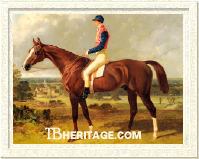
Discount won the Grand National
| |
THE CORSAIR (1836), was bred by King William IV, from Gulnare by Smolensko, and in-bred to the good mare Maria 4 x 4 and also to Trumpator. His first start was the 2,000 Guineas, which he won. He did not place in Bloomsbury's Derby. He ran second to Epidaurus in a sweepstakes at Doncaster. At age four he had a solid record, running third to Clarion and Bloomsbury in the Cesarewitch; second to Hetman Platoff in Newmarket's Craven Stakes; third to Hetman Platoff and La Sage Femme in the Wolverhampton Stakes, and second to Hetman Platoff in the Wolverhampton Cup.
Sir Hercules' son, the gelded DISCOUNT (1838), from Minikin by Manfred, won the Grand National Steeplechase in 1844. |
ROBERT DE GORHAM (1839), from Emilius daughter Duvernay, ran second in Attila's Derby, and at age four ran second to Alice Hawthorn in Ascot's Queen's Vase and third to Ralph and St. Francis in the Ascot Gold Cup that year. He retired to Mr. Gratwicke's stud. His son, Sir Colin, won the Epsom Cup at age three, beating Chevalier d'Industrie, but his fillies were better. Countess (1847) ran second to Rhedycina in a race for two year olds at Brighton, and then ran third to her in the 1850 Oaks. The bay Anspach (1848) was second to Aphrodite in the 1,000 Guineas, and won Nassau Stakes at Goodwood at age three. Hesse Homburg (1848), from The Landgravine, by Elis, ran third in the Oaks to Iris, third to Nancy in the Chester Cup, and won the Newmarket Handicap at age three, and at age four won the Brighton Stakes.
NEWCOURT (1840), from Sylph by Spectre, ran third to St. Lawrence and Mendicant in the Chester Cup. He got a good running son in Cotswold (1853). Newcourt's sister, Lady Lift (see below) was sent to France when in her teens and became the dam of two very good winners.
HAGLEY (1845) owned by Mr. Griffiths, ran fourth to Fernhill in Epsom's Great Metropolitan Stakes at age three; in 1850 he won the Hunt Cup at Ascot.
LANDGRAVE (1846), was bred by Mr. Gratwicke from The Landgravine, by Elis. He was barely beaten in the Cesarewitch of 1849, at age three. At age four, he ran third in the Cesarewitch, won the Triennial at Newmarket, and went on to win the Cambridgeshire. He also ran at age five.
The bay HOTSPUR (1846) ran second by a short neck to The Flying Dutchman in the Derby of 1849, and is seen in the pedigrees of some jumpers.
KNIGHT OF THE SHIRE (1849) ran third to Red Hind in the Criterion at Newmarket, beating Stockwell; at age three he ran third to Weathergage in the Cesarewitch, and won the Cambridgeshire Stakes Handicap.
GUNBOAT (1854), bred by Sir John Shelley from Yardarm by Sheet Anchor, ran second to Saunterer in a plate at Newmarket at age three, and later was a noted sire of jumpers. He sired Torpedo (1876), sire of two Irish Derby winners and also an excellent steeplechase sire. Gunboat also sired the great mare Frigate, who won Ireland's Conyngham Cup near the beginning of her career in 1883, and who ran second in the 1888 Grand National Steeplechase and won that event in 1889.
LIFEBOAT (1855), a brother to Gunboat, was sired when Sir Hercules was 29 years old. At age four he won the Trial Stakes and Queen's Plate at Northampton, beating Fisherman in both races, and went on to win Epsom's Great Metropolitan Handicap over 2-1/4 miles, and placed second to Underhand in the Northumberland Plate. He established a sire line with his son The Mariner (1865, from Wild Cherry by Surplice), which extended to Cabin Boy, who also won the Great Metropolitan. The Mariner's sister, Sea Gull (1866) was dam of Beaudesert (1877, by Sterling), who won Newmarket's Middle Park Stakes and sired the classic-winning Argentine racehorse and leading sire there, Stiletto, and also dam of Belle Rose, tail-female ancestress of the racehorse and U.S. leading sire Sweep.
SIR HERCULES (1856), bred by Sir John Shelley, and foaled when Sir Hercules was thirty years old, did well at age three, in 1859, running second to Gamester in Newmarket's St. Leger, and second to Thormanby in York's Eglinton Stakes.
Daughters of Sir Hercules
|

Cruiskeen
| |
The Irish-bred CRUISKEEN (1834) out of Brandy Bet who was by a Waxy Pope son, Canteen, was owned by Lord Milltown, who later bred her son, Russborough. She won the Claret Stakes at the Curragh in her juvenile year, but went unplaced in the Anglesea Stakes. At age three, she failed to place in the Madrid Stakes and the Challenge Madrid Stakes at the Curragh, and then ran third in the Northumberland Handicap, won by Harkaway, with Birdcatcher second. She ran unplaced again in the Wellington Stakes at the Curragh in September, and then ran second in a race limited to mares, over four miles, beaten by her crop-mate, MARIA. After failing to place in the Kirwan Stakes at the Curragh in October, she won a small race the next day, beating six others. Her season ended with a second in the Doric Stakes to Maria. |
At age four she beat her nemsis, Maria, in a Queen's Plate at the Curragh in April, and also beat the colt Frank in a match for 100 sovereigns. In June she won the Kirwan Stakes, and emboldened by her wins, Milltown shipped her over to England to race. She ran unplaced in her next three races--the Liverpool Cup, the Holyoake Stakes at Wolverhampton, and the Park Stakes at Heaton Park, falling in the latter race. She was retired for the season, but stayed in England.
In 1839, age five she ran unplaced for the Chester Cup, the Cheshire Stakes, and the Shrigley Cup at Newton. Then she ran second in the Stand Cup at Liverpool, beating four other horses. This was followed by a a win in the Staffordshire Stakes at Lichfield, and the Heaton Park Stakes at Liverpool. She then won the inaugural Cesarewitch Stakes handicap at Newmarket over 2-1/4 miles, very lightly weighted at 6 st-6lbs. She did not place in her three other races that year. In 1840 she ran off course in the Chester Cup, and then ran sixth in the Liverpool Cup. She won a small race at Warwick, beating the Sir Hercules son, The Corsair, and three others, and then, running in good company, failed to place in six more races. She was sent back to Ireland in the fall, and in October at the Curragh she won a race worth £205, and the next day, carrying 9 st-4lbs, won a three mile Queen's Plate there. In 1841 this long running mare began her season by winning the Queen's Plate at the Curragh in April. She was then shipped back to England where she finally won the Chester Cup, beating a large field of twenty. In July she went to Liverpool and won the Stand Plate, beating nine horses. She ran eight more times in England, and was mercifully finally retired to the stud, back in Ireland.
Her son, Russborough (1847, by Tearaway), won the Railway Stakes handicap at the Curragh in 1850, beating Blucher, and was then sold to Dublin banker Mr. Mangan, and was sent to England. He ran a dead-heat with Voltigeur for the Doncaster St. Leger (and lost the run-off), and after running unsuccessfully in England for a while was sent back to Ireland in 1852, winning two Queen's Plates at the Curragh. In 1853 he won a Queen's Plate at Edinburgh over two miles. |
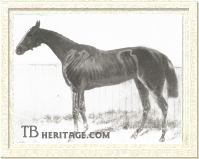
Brunette
| |
The chestnut BRUNETTE (1834), bred by William Allen of Ginnetts in County Meath from a half-bred mare, was the star of Irish steeplechasing in her day. Sold to John Preston, who was almost always also her jockey, she was conveyed in her own horse-drawn van to her races. Her best year was 1845, when she won six major steeplechases in Ireland. Brunette won the Kilrue Cup at Ashbourne, one of the most important chases in Ireland at the time, four years in a row. In this race she beat Mathew in her 1846 victory; he went on to win the Grand National Steeplechase at Aintree. Also in this race in 1843 she beat another good chaser, Peter Simple, and also bested St. Leger in this race; the latter went on to become the first Irish winner of the Grand Steeplechase de Paris (in 1847).
|
In 1847, age 13, she ran in Aintree's Grand National, gamely finishing sixth, despite a throat infection that affected her ability to jump. Sold to Captain William Hely-Hutchinson of Palmerstown, she became a broodmare, living to the age of 22.
The Irish-bred, black WATER WITCH (1833), from Mary Anne, a Waxy Pope daughter, won the first running of the Mulgrave Stakes over the new Mulgrave Mile Course at the Curragh in 1836, beating Birdcatcher, and ran to the age of four, placing in various races at the Curragh. She became second dam, through her daughter Maltese (by Hetman Platoff) of a small, temperamental, in-bred bay colt (by Birdcatcher) bred by William Disney at Lark Lodge: Knight of St. George, sold to Christopher St. George and then on to B. Morris, who was the owner of Kingston. He won as a juvenile in Ireland, and then was shipped to England, where he won Doncaster's St. Leger and some other races, including the County Stakes at Worcester. He got the stakes winning Knight of St. Patrick (1858, out of Pocohontas), sire of Moslem, who dead-heated with Formosa for the 2,000 Guineas, Dan O'Connell (1856), who sired Grand National Steeplechase winner The Liberator (1869), and also got some daughters that bred on. Knight of St. George was later exported to the U.S., where he became a good sire.
MARIA (1833), out of The Pleiad by Bob Booty, was bred by Joseph Osborne, and named by his son, the turf writer Joseph Osborne, after Ireland's Lord Lieutenant's wife. She was considered the best filly of her day in Ireland: at age three she ran second to Birdcatcher in the Madrid Stakes, and in September won the Wellington Stakes, beating him and ten others, and at the same meeting, she ran third to Whim and Bidcatcher in the Challenge Stakes. At age four, she won the Queen's Plate over four miles at the Curragh in September, beating Cruiskeen, and in October, the Doric Stakes, beating Cruiskeen, who was second, and Birdcatcher, who ran unplaced. At age five, she ran second to Cruiskeen in the Queen's Plate in April at the Curragh. Osborne later was the owner of the dual-Grand National winner Abd-el-Kader (1850 and 1851).
The brown PARAGUAY (1835, Family 3 - n), from the Partisan daughter Paradigm ran in the 1838 Oaks, unplaced. Sent to Australia, she became dam of Sir Hercules by Cap-a-Pie, an extremely influential sire who got, among others, Yattendon, winner of the AJC Derby, St. Leger and Sydney Cup (16 furlongs) and a top sire, and The Barb, winner of the AJC Derby and Metropolitan, the Melbourne Cup and a host of other races including the 24 furlong Randwick Plate. Another Sir Hercules daughter, BLACK BESS (a.k.a. Gaslight) (1850, from Factory Girl by Lamplight) was sent to Australia and produced Fireworks (1864) , winner of the VRC Derby and St. Leger, among other races, and later sire of Goldsbrough, an influential sire there.
JUDY CALLAGHAN (1835, Family B13), was one of two Sir Hercules daughters that are founders of recognized half-bred families (their dams untraced). Judy Callaghan produced Chester Cup winner Intrepid (1841, by Camel son Accident, and so in-bred to Whalebone), and Madeline (1849 by Orlando), dam of a good runner, The Monk (1857, inbred 3 x 3 to Sir Hercules). CERTE (birthdate unknown, probably 1833-34, Family B24) was third dam of Small Talk, winner of Ireland's 4 mile steeplechase, the Conyngham Cup, later the dam of National Produce Stakes winner Chit Chat (1893, by May Boy, another half-bred from Family B1). Another half-bred mare, unnamed, by Sir Hercules (birthdate unknown, probably 1833-34, Family B-11) was second dam of the 1885 Grand Prix de Steeplechase winner Redpath, (1877, by Uncas).
An unnamed Sir Hercules daughter (1839, Family 2 - t), out of Electress, by Election, was an excellent producer. She was the dam of two July Stakes winner, Iodine (1845, by Ion) and Gin (1855, by Orlando), and of Gin's brother, Claude Lorraine (1854, by Orlando), who won the Ascot Stakes. Iodine bred on, and a number of great stayers descended from her.
VIBRATION (1839, Family 22 - b), out of the Emilius daughter Echo (also dam of Sting, by Slane, exported to France and a top sire there), won the Ascot Stakes and the Queen's Plate at Goodwood, and ran second to Knight of the Whistle in the Middlesex and Surrey Stakes at Hampton in 1842, at age three. From her descended the classic winner and sire St. Frusquin (1893), sire and Richmond Stakes winner St. Gris, Kentucky Derby winner Count Turf, and a host of other winners on multiple continents. Her sister, VENUS (1840, Family 22 - c), was dam of 1,000 Guineas winner Aphrodite and tail-female ancestress of a host of stakes winners and classic winners, such as French classic winner and sire Omnium II (1892), and English Derby winners Merry Hampton (1884) and Captain Cuttle (1919).
QUEEN OF THE MAY (1848, Family 7), from the Malek daughter Myrrha (also dam of Yorkshire Oaks winner Ellen Middleton -- dam of Derby winner Wild Dayrell -- by Bay Middleton) was owned by Mr. Foljambe. She ran third to Cymba in the Oaks, and won the Filly Stakes at York that year. She became the tail-female ancestress of many good stakes winners, such as Cambridgeshire Stakes winner Hackness (1878); Rose O'Lynn (1944), winner of the Prix de Conde and exceptional dam of Buisson d'Or (Prix Royal Oak and others), Buisson Ardent (French 2,000 Guineas and others), Al Mabsoot (Prix Lupin) and Venture (St. James's Palace Stakes and others); and Luciano (1964), winner of the German Derby and other top races there.
GRAMACHREE (1844), a sister to Birdcatcher and Faugh-a-Ballagh, and a surviving twin, was second dam, through a daughter, of the sturdy Selim (1863). He won a plate at the Curragh at age three, and in June, won a royal plate at the Curragh meeting, the next day won the first running of the Irish Derby (initially run over 1 mile-6 furlongs), and won royal plates on each of the two days following the Derby. At age four he won a royal plate at the Curragh in June, another at Bellewstown, and a third at Londonderry in August, plus wins at the Maze and at Roscommon.
LADY LIFT (1844), bred by Edward Griffiths, was out of Sylph, by Spectre, and so a sister to Newcourt. In Griffiths' stud, she produced several foals before being sold to France in 1858, purchased by Count Frederic de LaGrange, who was establishing his new stud at Dangu, having bought, the year before, all the horses belonging to Alexandre Aumont, including the French Triple Crown winner, Monarque. The count also owned the 1864 English 1,000 Guineas winner Fille de l'Air (by Sir Hercules son Faugh-a-Ballagh) and Gladiateur (the French-bred winner of the English Triple Crown in 1865). Lady Lift produced Le MarÈchal (1860, by Monarque), winner of the Gimcrack Stakes at Doncaster and the Zukunfts Rennen in Germany, and his brother, the small Consul (1866, by Monarque) one of the best sons of his famous father. Consul was a good juvenile, winning for his owner- breeder, Count Frederic de LaGrange, the Criterium, France's most important race for two year olds. At age three he ran second to Pandour in the Prix de Longchamp, then went on to win the French 2,000 Guineas, the Prix de Guiche, and then the French Derby, beating the favored Glaneur. He ran fourth in the Grand Prix de Paris, and won one other race that year, the Prix de Seine-et-Marne. He became a successful sire in France.
CLARINDA (1846), out of Mustard, was the second dam of Uncas, winner of eleven races as a juvenile in both Ireland and England, and later a good sire who got four Irish Derby winners, and had an influence on steeplechasers, and was dam sire of of the 1902 Grand National Steeplechase winner, Shannon Lass.
--Patricia Erigero |
|
|
|

